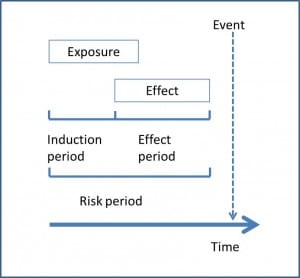Case-crossover studies.

Case-crossover studies focus on the event and try to see something that favors it, comparing the exhibitions of immediate with previous moments.
When we want to know the relationship between an exposure or intervention and an effect, the ideal is to do a randomized controlled clinical trial. Of course that is not always possible, usually due to the nature of the exposure. For example, suppose you want to know the effect of smoking on myocardial infarction. As anyone can understand, we cannot randomize two groups and put one of them to smoke two packs a day to see if the get infarcted. Ethics and common sense prevent us from it, in addition with the difficulty in finding participants for a trial of this nature.
In cases like that we must rely on observational studies. In our example, we might as well perform a case-control study. So, we would select two groups depending on whether they have had infarction (cases) or if they have not had (controls) and we would compare the exposure level between the two groups to try to determine whether there is an association between exposure (smoking) and effect (heart attack).
The key point of this type of study lies in selecting the adequate controls, which must be representative of the level of exposure to the risk factors evaluated in the population from which the cases proceed.
An appropriate selection of controls is even more difficult when the effect is of sudden production. For example, if we want to know if a heavy meal increases the risk of stroke we would have more difficulty in collecting representative population controls, as risk factors may act moments before the event.
Case-crossover studies
To avoid these difficulties, someone applied the principle of “you make your bed, you lie in it” and designed a type of study in which each participant acts, simultaneously, as his own control. These are the so called case-crossover studies.
These studies focus in the moment when the event occurs and try to see if there was anything unusual that has favored it, comparing exposures immediate aftermath of the event with other previous moments that act as controls. Therefore, they compared case moments with control moments, acting each individual as his own control.
Periods
For the study to be valid from the methodological point of view, the authors must clearly describe a series of characteristic periods of time. The first is the induction period, which is time delay that occurs from the beginning of exposure to production of the effect.

The induction period is usually very short most of the times, so the risk and effect periods are usually equivalent. The attached figure shows the relationship among the three periods to better understand them.
It is essential that these three periods are specified clearly, since a bad estimation of the effect period, both by excess or by deficiency, causes a dilution of the effect of the exposure and makes it difficult to detect.
Some of you will tell me that these studies are similar to other studies with auto controlling, such as the matched case-control studies. The difference is that in the later one or more controls are chose for every case, while in the case-crossover study each participant is his own control. They also seem a bit like crossover trials, in which all participants are subject to intervention and control, but these are experimental studies in which the researcher is involved in the production of the exposure, while the case-crossover are observational studies.
In what case-crossover look like matched case-control studies is in its statistical analysis, with the difference that in case-crossover case moments and control moments are compared. Thus, it is habitual to use models of conditional logistic regression, being the most common measure of association the odds ratio.
We’re leaving…
And here we leave this topic for today. Just comment that everything we have said refers to the so called unidirectional case-crossover studies, in which there is a very precise temporal relationship between exposure and effect. For situations in which exposure is more maintained, there are other types of crossover studies, the so called bidirectional, in which periods after and before the effect are selected. But that is another story…
